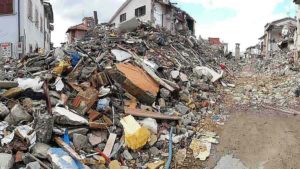
The cumulative stresses caused by historic earthquakes could provide some explanation as to why and where they occur, according to new research.
Scientists have previously struggled to identify patterns for earthquakes happening in hazardous areas around the world, with the suggestion that they appear to strike largely at random.
However, a study published in Nature Communications suggests that Coulomb pre-stress—the static stress present on a fault plane prior to rupture—can go some way to explaining both historical and modern series of earthquakes.
The study was led by Dr. Zoë Mildon, Lecturer in Earth Sciences at the University of Plymouth, and features research conducted during her Ph.D. at University College London (UCL). It also involved researchers from UCL, Birkbeck, University of London and Tohoku University in Japan, and was funded by the Natural Environment Research Council and the Japan Society for the Promotion of Science.
It combines centuries of written evidence of earthquake damage to towns and villages with state-of-the-art modelling, through which scientists demonstrate that positive stresses—a legacy of previous earthquakes in the region—are present on faults before the majority of earthquakes occur.
Dr. Mildon recently presented some of her findings at the 2019 General Assembly of the European Geophysics Union, and said: “Earthquakes are caused by rock sliding past each other along fault lines which causes the forces and stress in the surrounding rocks to change after a big earthquake. It is often assumed that the nearest fault to a particular earthquake will be the next to rupture. However, our study shows this is never the case so typical approaches to modelling Coulomb stress transfer (CST) have limited potential to improve seismic hazard assessment.
“Our model adds the stresses of lots of earthquakes together and shows that in the majority of cases fault lines are positively stressed when they rupture. It is a step change in modelling CST and shows this is an ignored yet vital factor when trying to explain earthquake triggering.”
The research focuses on the central Apennines region of Italy, which has regularly been struck by earthquakes over the past 700 years.
These historical earthquakes are known about from written records started in 1349 that detail the amount of damage and lives lost in individual towns and villages throughout the region. By looking at the locations and amount of damage, scientists can work out where, when and how large historical earthquakes occurred.
Looking at the locations of earthquakes over the last 700 years, it would be easy to assume these incidents occurred at random as they jump around the region.
But using their new method, they were able to demonstrate that 97 per cent (28 out of 29) of the earthquakes between 1703 and 2016 occurred on faults that were either wholly or partially positively stressed.
This includes the series of earthquakes that destroyed the town of Amatrice and Norcia in 2016, leaving almost 300 people dead and whole towns reduced to rubble.
Dr. Mildon added: “Earthquakes are hugely destructive to both people and property, and the Holy Grail of earthquake science would be to predict where they are going to happen and when. We are a very long way from that, and indeed it may never be possible to accurately predict the location, time and size of future earthquakes. Our research, however, could be a starting point in helping us develop better forecasts of which fault lines might be more susceptible based on previous tremors.”
Reference:
Mildon et al: Coulomb pre-stress and fault bends: ignored yet vital factors for earthquake triggering and seismic hazard, Nature Communications (2019). DOI: 10.1038/s41467-019-10520-6
Note: The above post is reprinted from materials provided by University of Plymouth.










